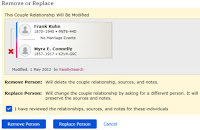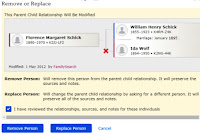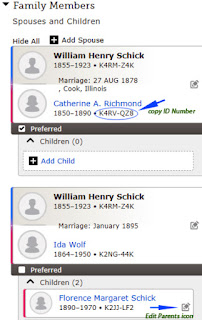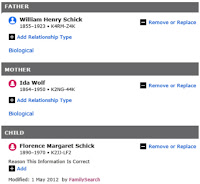 My Mother, Anni Maria Harjula (Paulin, George, Madrick), was born May 12th, 1918 in Pori, Finland.
My Mother, Anni Maria Harjula (Paulin, George, Madrick), was born May 12th, 1918 in Pori, Finland.
That is another story all in itself, that I will tell later.
My Mother told me of the story of her moving from Finland to the United States. It was during the time of WWII in the year of 1941.
She had married a man in Finland, though he was not kind to her and she was afraid of him, so she saved up her money to get on the first or last ship she could to get to America. Her husband’s name was Tauno Vilhelm Paulin, born September 26, 1914, in Helsinki. They were married November 27, 1938. I have not been able to find a marriage record, though many people in Finland do a common law type of marriage that is not recorded, so that may have been the case. I do have a picture of their wedding day.
This is the story of my mother’s travels from Finland to America.
This is a newspaper that my mother saved and shows a picture of my mother, Anne Harjula Paulin George, standing next to her actress friend, Sara Strengell. In this newspaper clipping, she wrote, “1941 – The Bombing of ship “Carolina Thordén”. Stayed at the Faroe Islands for 7 to 10 days waiting for another ship. A Swedish ship took all of us to Cuba. She told me that she had to stay in Cuba for some time because of the war. During that time, they stayed at the Naval base in Cuba and each year the Cuban Navy selected a Navy Queen. She was made the Navy Queen that year in Cuba. I do not believe she was aware that several of the survivors from the bombing, did not survive.
I found from an article, “In Treacherous Waters: Two Ships and a Rendezvous with Infamy by Brian B. Magnusson”, a more detailed account of what actually happened.
In mid-March 1941, while the "Venezuela" still lay at anchor outside Gothenburg, another ship, the Finnish-registered “Carolina Thordén”, was busily taking on its cargo of paper and cellulose at Petsamo. Its departure date was scheduled for 21/22 March. In addition to its crew, some thirty-three passengers were registered for the crossing to Philadelphia, including Finns, Finland- Swedes, Swedes, Swedish Americans, and Finnish Americans. There were also a small number of “foreigners,” as well as at least one Jewish family. The passengers represented a wide variety of professions and stations in society, ranging from a Finnish diplomat and a stage starlet to Winter War veterans, a Swedish count, and a Finnish-American Lutheran minister. There were also children, at least one of whom was an orphan on his way to America to be adopted. A name to later gain international status was that of Lars Schmidt, at the time an adventurous, aspiring young theatre producer who later became one of Europe’s best-known producers of American plays and musicals. Thanks to Schmidt, a number of compelling stories from the "Carolina’s" journey have been preserved and are mentioned here.
 In an associated press article in December 1940, Captain Carl Gabrielsson of the "Carolina Thordén", said he had received sailing clearances from both England and Germany for a crossing to New York; his port of departure was listed as Gothenburg. Apparently, somewhere beyond the Kattegat the ship was strafed by a German warplane and was left “pockmarked with machine gun bullets.” In a chilling commentary, Captain Carl Gabrielsson stated that “in one day in the North Sea, his wireless operator had picked up distress signals from no fewer than 13 ships.” Then, three months later, 21 March 1941, the “Carolina Thordén” lay tethered in Liinahamari on Petsamo Fjord. The ship’s arrival had been delayed by several days, but cargo and provisions were now being loaded, and passengers were boarding. Departure was scheduled for some time during the night; destination: Philadelphia.
In an associated press article in December 1940, Captain Carl Gabrielsson of the "Carolina Thordén", said he had received sailing clearances from both England and Germany for a crossing to New York; his port of departure was listed as Gothenburg. Apparently, somewhere beyond the Kattegat the ship was strafed by a German warplane and was left “pockmarked with machine gun bullets.” In a chilling commentary, Captain Carl Gabrielsson stated that “in one day in the North Sea, his wireless operator had picked up distress signals from no fewer than 13 ships.” Then, three months later, 21 March 1941, the “Carolina Thordén” lay tethered in Liinahamari on Petsamo Fjord. The ship’s arrival had been delayed by several days, but cargo and provisions were now being loaded, and passengers were boarding. Departure was scheduled for some time during the night; destination: Philadelphia.
At Petsamo, the pre-war community with its elegant hotel, Orthodox church, and harbor facilities had suffered extensive damage in the recent fighting and holding areas for passengers were now at best primitive. In other words, for any traveler leaving Finland by way of Petsamo, the journey was physically and emotionally draining and offered neither comforts nor amenities. The convoys departed from Rovaniemi train station in the evenings, and at least part of the rough, overland trek was in darkness. Passengers were urged to have food with them, and blankets to stay warm in the small, well-packed vehicles. The Petsamo Corridor and the free port at Liinahamari were open to passenger traffic approximately fourteen months until the beginning of the War of Continuation in June 1941. Though relatively short-lived, this escape route was of immeasurable importance to thousands of people hoping to leave on vessels like the “Carolina Thordén”. The degree to which this funneling of Atlantic travelers succeeded strikes one as nothing short of incredible when one remembers that motor-ships like those of the Suomi Line could theoretically accommodate no more than twelve passengers, in addition to no less than twenty-one crewmen. But given the tense, inter-war atmosphere in Finland, regulations were being compromised for the sake of expedience and additional shipboard accommodations were being improvised. One is hardly surprised, then, to read that the March 1941 passenger list for the “Carolina Thordén” was thirty-three men, women, and children representing a variety of nationalities and faiths.
The British occupation of the Faroe Islands, however, had created a major problem, as Great Britain had established an inspection facility at Tórshavn, where they were obliging Swedish and Finnish ships to stop for contraband searches. In accepting the British demands—something Nazi Germany for obvious reasons would vigorously oppose—the Swedes pursued what might be termed a policy of quiet duplicity. In general terms, this involved the following: upon departing from Scandinavia, Swedish and Finnish ships underwent inspection at German checkpoints and then took the North Atlantic route west—between the Faroe Islands and Iceland—above the German blockade zone. The ships would quietly slip in and out of Tórshavn in their journeys to and from the Americas, and as long as blockade zones remained as they were in the North Atlantic, nobody would be the wiser. A crisis arose, however, when, on 26 March 1941, the Germans extended their blockade northward to Iceland and Greenland. As a result, the movement of Swedish and Finnish traffic through Tórshavn could no longer be concealed, and Nazi Germany had to be told of the policy being pursued. The reaction from Berlin was predictable: all led traffic would cease as of 15 April, and a new agreement was required before traffic could resume. Further, as the Germans expressed it, it would “now be impossible to guarantee the safety of Swedish or Finnish vessels in the vicinity of the Faroe Islands.” Sweden immediately began seeking ways to resurrect led traffic as soon as possible. In other words, the winds of adversity had already begun to blow before the “Carolina Thordén” and the "Venezuela" left Scandinavian waters.
 |
The sinking and burning ship of
“Carolina Thordén” while passengers
were still aboard. |
It is mentioned that Captain Gabrielsson had received sailing clearance from both the English and the Germans. It is not clear if the Carolina was obliged to put into Tromsö for Kontroll by German authorities, although this was undoubtedly the case. Lars Schmidt observed that Captain Gabrielsson wanted to steer a northerly course “so as to avoid the Faeroe Islands” and apparently the German blockade zone. But this was not to be. British authorities insisted on an inspection in Tórshavn, and the “Carolina Thordén” arrived in the Faroes on 26 March. The stay there lasted only a few hours, and once clearance was given the ship departed what Schmidt described as a depressing town in “dirty gray light.” An hour or so out of Tórshavn—at a point where passengers dared to believe “nothing more would interrupt their journey on to America”—a German plane was sighted. Shortly afterward, the ship was attacked by two “He 115” German seaplanes. Lars Schmidt recalls the first bomb missing the ship and landing in the sea ahead. Afterward, “there was one direct hit after the other.” He recalled running from one side of the ship to the other and then back again. Panic ensued, with concussions, smoke, and flames that blurred later recollections of the events. Most reports describe the Carolina as being bombed and strafed. Other say torpedoes hit the ship. (The He 115 was one of Germany’s most versatile aircraft and was equipped with bombs, torpedoes, and machine guns.) Whatever weaponry was used, the onslaught ignited a fire amidships that spread rapidly and raged out of control, ultimately consuming most of the vessel. During the attack, one passenger was killed, a Finnish diplomat, while others were injured. Lars Schmidt recalled that in all the confusion, someone was praying. Fortunately, British and Faroese craft reached the vessel during the attack and, braving heavy machine gun fire, picked up terror-stricken passengers and crewmen. Reports tell of a frantic abandoning of the ship. Cabins had been destroyed or were engulfed in flames and precious belongings were lost. Many are said to have left virtually everything aboard, including important visa applications for entering the United States. Strafing of the rescue craft continued long into the rescue operation, as did intermittent bombing of Tórshavn in the days to come.

The back side of this Photo said: “British Official Photograph No. K 213. Germans bomb Finnish steamer. The 3,645-ton Finnish steamer, “Carolina Thordén” bound for America was bombed by a German aircraft off Thorshayn, Faroe Islands. This photograph was taken by one of the passengers, a Helsinki businessman, rescued by Faroes fishermen. The Finnish steamer with her superstructure blazing, and boat hanging useless and burning.”
Survivors were brought ashore and quartered in Tórshavn and at other points on the islands. The wounded were treated; all were traumatized to varying degrees. As the “Carolina Thordén”, was being bombed and its passengers strafed, two other Nordic ships were on their way to the Faroe Islands for British inspection. One was the Finnish “Mathilda Thordén”, en route to Petsamo from Galveston, Texas. The other was the Swedish America Mexico Line freighter “Tunaholm”, now on its way west. It appears the Mathilda made port first in Tórshavn, where its cargo was inspected and it picked up Captain Gabrielsson, his crew, and a few of the “Carolina Thordén” passengers who wanted to return to Finland. Most of the passengers from the “Carolina Thordén”, however, selected to continue their journey to America with the next ship possible, in this case, the “Tunaholm”, due to arrive sometime around April 10. Some of the passengers set sail on April 11, 1941, to Cuba on the “Tunaholm”. Among them were Georg Möller, an inventor and Swedish American; Sara Strengell, a Swedish-Finnish actress; the aspiring theatre producer Lars Schmidt; Reverend Frans Uno Salminen, and my mother.
The other survivors from the bombed ship stayed at the Faroe Islands. Among the survivors of the “Carolina Thordén” were eight people, who soon found their fates linked to the Swedish led ship Venezuela and its captain, Gustaf Adolf Salomonsson. Regrettably, several of these passengers remain sketchy, although it is known that four were adults and four were children. All were Finnish. Marta Regina Olsson, 32, from Helsinki; and Nanny Virginia Saarinen, a nurse during the Winter War, were two of them
On April 14, 1941, the “Venezuela” ship left port with eight of the survivors en route to Rio de Janeiro. Reports shared that it mysteriously disappeared in the North Atlantic. Only months later, did the evidence show that only three days after sailing on April 17th, the “Venezuela” had been torpedoed by a German submarine U-123, with the loss of all 49 persons onboard.
In a journal, I read, that Aaron Nemeschansky, (1894-1983), who was born in Turku, Finland, was married and had two children. His wife was born in Ukraine and was not a Finnish citizen. In March 1941, the family immigrated to the USA from the North Sea ice-free Liinahamari harbor in Petsamo, then part of Finland, on the “Carolina Thordén”. March 26, 1941. The journal went on to say that two German planes bombed the ship, which caught fire and was towed to a port near Tórshavn on the Faroe Islands. Aaron and his family lost their luggage, passports and entry visas to the USA. Luckily, Aaron declined an offer to let his wife and children continue their journey onboard the ship “Venezuela” bound for Rio de Janeiro, as this ship was torpedoed and sunk on April 17. 1941. On May 4, 1941, the family continued their journey from Tórshavn to New York on the “Marisa Thordén”, along with the last of the survivors of the “Carolina Thordén”.

Little did my mother know that if she had waited until the next ship, she would not have survived. Fate had it for her to live, and thus for all of us to live.
While my mother was in the Faroe Islands and Cuba, she became good friends with both, Sara Strengell, the actress and Lars Schmidt, the producer. When she finally gets to New York, they help her to become a New York model. After a while, my mother was able to come to the United States. She arrived in Miami, Florida. Manifest papers held her in Miami for BSI inspection.
Her stepfather, Antti, who is my grandmother’s 2nd husband, had to drive there and come to pick her up, in order for her to be allowed in the States. BSI stands for Board for Special Inquiry. I am not sure why she was held for the inquiry, maybe because she did not come on the ship she was supposed to, that was bombed, maybe because her visa was lost in the ship bombing, maybe because she was in Cuba, maybe because of the war.
Finally, she was allowed to go the New York, where she rejoined with my grandmother, Martta Harjula (Parssinen). And this is when she with the help of her new friends, became a New York model. So, this is the end of this part of the story. More, another time.












